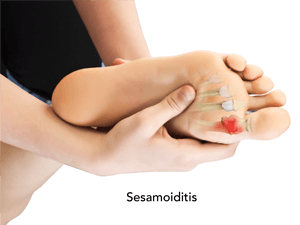What is Sesamoiditis?
In the foot, the sesamoid bones normally lie just beneath the big toe joint. They run in a tendon that flexes the toe down and their normal function is to stabilise the big toe joint and to give additional power to toe flexion. The two sesamoid bones form a joint with the end of the first metatarsal. Inflammation of these two bones is termed Sesamoiditis.
What are the symptoms of Sesamoiditis?
Pain on the undersurface of the foot, at the level of the big toe joint, is the commonest symptom. This pain is normally worse when pressure is applied to the area or when the doe is lifted up away from the floor. These actions apply pressure to the sesamoid bones as they come into close contact with the end of the first metatarsal bone. The causes are normally trauma, either acute or repetitive (such as long-distance running), unsupportive footwear or overload of the forefoot due to tightness in the calf muscle.

How is Sesamoiditis diagnosed?
History and clinical examination are key to determining the underlying diagnosis. X-rays can often appear normal so the best imaging modality is MRI.
What are my options for treatment?
Once the diagnosis and causation have been confirmed, treatment options can be considered. Avoiding the underlying cause is obviously important. Simple rest and abstaining from stressing the bones can be all that it required. For more persistent symptoms, an orthotic to offload the sesamoids can give excellent symptom relief and allow the bones to recover. Injection to the big toe joint can provide an anti-inflammatory effect which can also break the cycle of irritation and pain. Surgery is rarely required and has comparatively poor outcomes.
If you or someone you know has suffered an injury or is experiencing pain across their lower limbs or difficulty with mobility and would like a consultant-led review, please contact us. Grosvenor Orthopaedics have extensive experience in the treatment of knee-related injuries with excellent patient outcomes.
BOOK NOW
Grosvenor Orthopaedics have extensive experience in the treatment of foot & ankle -related injuries with excellent patient outcomes.
FOOT & ANKLE CONDITIONS
If you would like to learn about other foot & ankle conditions click the button below to find out more
FOOT & ANKLE TREATMENTS
If you would like to learn about other foot & ankle treatments click the button below to find out more
our specialist FOOT & ANKLE consultants
Foot & ankle care at Grosvenor Orthopaedics is lead by Mr Tim Sinnett. A graduate of Cambridge and Imperial College medical schools and leading academic and trauma consultant for Chelsea and Westminster NHS trust. He is further supported by the orthopaedic team here including other consultant surgeons, nurses and care staff.
Our team are well placed to manage and treat a diverse range of foot and ankle concerns utilising cutting edge diagnostic technology and treatment approaches, both surgical and conservative. Below is an overview of some of the conditions we treat but for a more thorough understanding please contact our team here
What some of our patients say
Miss NN
Thank you and please accept my gratitude for a successful knee surgery and overall a very positive experience. This gold medal is for you!


